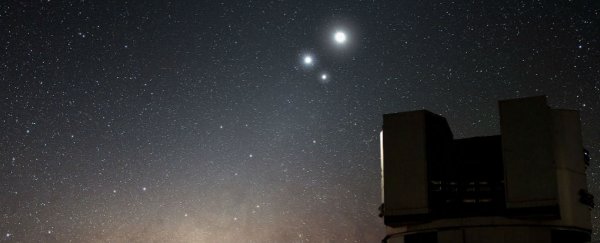The month of October is going to be particularly kind to astronomy enthusiasts this year, with Jupiter, Mars, and Venus set to draw unusually close to each other in the night sky, and the tricky-to-spot Mercury scheduled to make a rare bright appearance in the Northern Hemisphere.
You don't get this kind of show for free though - over the next three weeks, the best time to view Mercury will be at around 5:45am (ET), with Jupiter, Mars, and Venus expected to switch up their positions relative to each other every morning. So best set your alarm and get ready to tell your tired body it's all for science.
The first morning of note is Friday October 17, when Jupiter will finally catch up to Mars in the east so they're just 0.5 degrees apart - as Joe Rao at Space.com points out, that's about the width of the Moon in our night sky. This will be the first such conjunction between these two planets since 22 July 2013, and it'll be the last till 7 January 2018.
During the week of October 22 to 29, Venus will join the party, and the three planets will align, with just 5 degrees between them. "That's a big deal, because the next planetary trio won't occur again until January 2021," Bruce McClure and Deborah Byrd report for Earthsky.org.
Jupiter, Mars, and Venus will be closest together early in the morning on October 26, with Jupiter having such a close encounter with Venus, they'll form what's known as a 'double planet' for about 3 hours. "Another grouping of three planets won't happen again until 10 January 2021," say McClure and Byrd.
If that's not enough to get you up in the (very early) morning, perhaps the opportunity to catch a glimpse of Mercury will be.
"Mercury rises before the Sun all of this month and is surprisingly easy to see from now through Halloween," Space.com advises. "All you have to do is just look well below and to the left of our three other morning planets and above the eastern horizon during morning twilight, from about 30 to 45 minutes before sunrise for a bright yellowish-orange 'star'."
October 16 is set to be the best morning for Mercury viewing for this entire year, with its position relative to the Sun - about 18-degrees to the east of it - causing the light reflected off its surface to increase dramatically over the next couple of days, making it easy to see with the naked eye. And if you miss that one, on October 30, Mercury will be brighter than any star in the sky, except the brightest of them all, Sirius.
If planets aren't your thing (wait, what? who are you?) from October 20 to 22, you can view the incredible Orionids Meteor Shower. The shower will occur throughout October, but on the night of October 21 and the morning of October 22, it will hit its peak, often delivering around 20 meteors per hour. It's made up of the dust trails left behind by comet Halley.
Happy sky watching!
